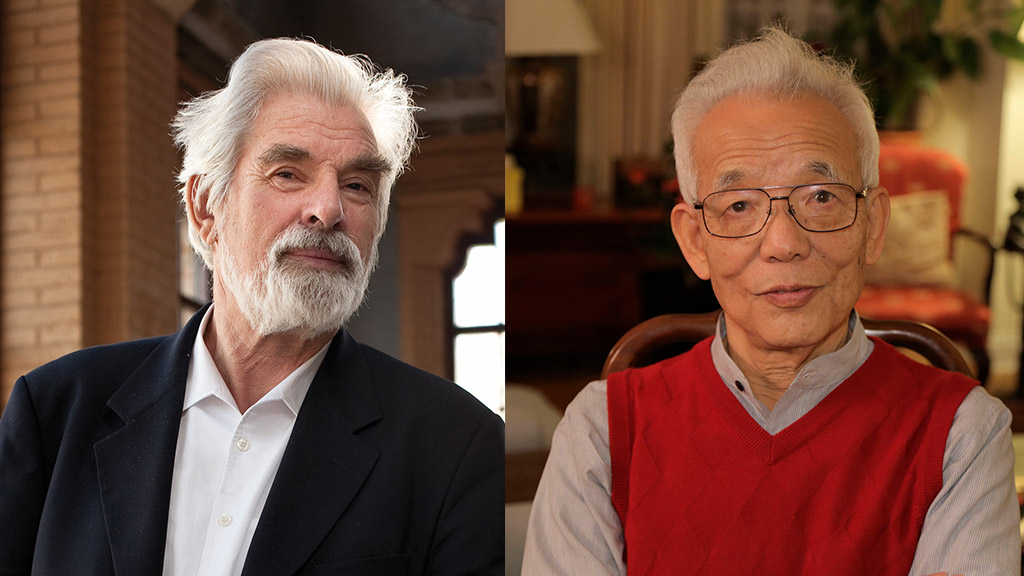
The Nobel Prize in Physics recognizes Klaus Hasselmann and Syukuro Manabe, Frontiers of Knowledge laureates in 2009 and 2016
Climate scientists Klaus Hasselmann and Syukuro Manabe have taken the Nobel Prize in Physics 2021 “for groundbreaking contributions to our understanding of complex systems,” together with the Italian physicist Giorgio Parisi, the Swedish Academy announced this Tuesday. Both Hasselmann and Manabe are past winners of the Frontiers of Knowledge Award in Climate Change, the German physicist in the 2nd edition (2009) and the Japanese scientist in the 9th edition (2016).
5 October, 2021
Hasselmann (Hamburg, 1931) and Manabe (Ehime, Japan, 1931) share one half of the Nobel “for the physical modelling of Earth’s climate, quantifying variability and reliably predicting global warming.” The other half goes to Parisi “for the discovery of the interplay of disorder and fluctuations in physical systems from atomic to planetary scales,” in the words of the committee elected by the Swedish Academy.
The Frontiers of Knowledge Award in the Climate Change category was bestowed on Hasselmann in its second edition “for developing methods which established that recent global warming trends are primarily attributable to human activities. Hasselmann, said the committee in its citation, “has crucially advanced the frontiers of scientific and public understanding of climate change.”
“The prize has been awarded to me for my work on developing climate models, but also for demonstrating that observed climate change can be attributed with a high degree of certainty to human impact. We have been able to demonstrate with the data at hand that human action is changing our climate, and this is an important scientific breakthrough. So I am very pleased it has been recognized. Everybody now understands that we are in danger from climate change,” said Hasselmann after receiving the Frontiers Award.
The German physicist and mathematician is author of a method known as “fingerprinting,” able to discriminate between natural contributions to climate change and the perturbations caused by the accumulation of atmospheric greenhouse gases.
“This landmark research overcame the prior difficulty of distinguishing human impact” in observed climate change, in the opinion of the Frontiers committee. Thanks to Hasselmann’s method, the United Nations Intergovernmental Panel on Climate Change (IPCC) could commit to paper in its 4th report (2007) that climate change was attributable to human factors.
The Frontiers of Knowledge Award in Climate Change in its ninth edition was shared by Manabe and American researcher James Hansen, “for developing mathematical models of the climate system, and for their pioneering use of these models to project the response of Earth’s climate to changing concentrations of atmospheric CO2, in the words of the citation.
Manabe’s contributions date back to the 1960s, when he set out to build a numerical model to simulate atmospheric behavior. Scientists then had no inkling that CO2 concentrations were augmenting due to fossil fuel combustion, and none could suspect that a process of this type might end up altering the Earth’s climate.
Manabe was doing postdoctoral meteorological research in Japan, when the call came in 1958 to join a colleague at the U.S. Weather Bureau in Washington. It was there that he began using computers in his work to create the first ever model of global atmospheric circulation, including elements like water vapor, winds and atmospheric heat transport. To get a firm grasp on this last variable, greenhouse gases had to be factored into the program.
At the end of the 1960s, while engaged in research at the National Oceanic and Atmospheric Administration (NOAA), Manabe completed his model which projected that if CO2 concentrations doubled, global temperature would rise by two degrees. Nowadays scientists can draw on scores of models to chart climate evolution; all of them heirs to those first developed by the Japanese researcher.
19 Frontiers awardees have gone on to win the Nobel Prize
Monday’s award to David Julius and Ardem Patapoutian, and the Swedish Academy’s award today to Hasselmann and Manabe, makes a total of 19 Frontiers of Knowledge Awards laureates that have later won the Nobel Prize in diverse categories.
Emmanuelle Charpentier and Jennifer Doudna , winners of the 2020 Nobel Prize in Chemistry, received with the Frontiers Award in Biology and Biomedicine in 2017. In the same edition, the Noble Memorial Prize in Economic Sciences was bestowed on Paul Milgrom and Robert Wilson , Frontiers awardees in Economics, Finance and Management in 2013 and 2016 respectively.
In 2019, four Nobel prizes went to researchers previously distinguished with a Frontiers of Knowledge award: Abhijit Banerjee and Esther Duflo in Economics (2008 Frontiers laureates in Development Cooperation) and Didier Queloz and Michel G. E. Mayor in Physics (2011 Frontiers laureates in Basic Sciences). In earlier editions, Shinya Yamanaka and James P. Allison , winners in the Biomedicine category of the awards, received the Nobel Prize in Medicine in 2012 and 2018 respectively; and Robert J. Lefkowitz , another Biomedicine laureate, won the Chemistry Nobel in 2012. In Economics, Finance and Management, three Frontiers laureates besides Milgrom and Wilson were subsequently awarded the Economics Nobel: Lars Peter Hansen (2013), Jean Tirole (2014) and Angus Deaton (2015). And finally, William Nordhaus received the 2018 Nobel in Economics after winning the Frontiers Award in Climate Change earlier that year

